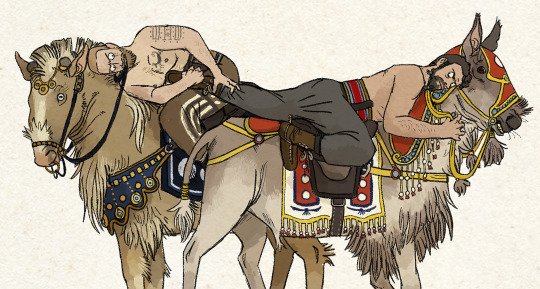#unaggressive and relatively chill 90% of the time) fucking HATES so much like just foaming at the mouth pissed off that this guy exists
Explore tagged Tumblr posts
Text

Brakul participating in the khaitwrestling tournament in the city of Wardin’s annual games. He is grappling with his beloathed rival, a Titen youth with a cooler beard named Gijo Sihgawe.
Brakul is using a technique where he attempts to gain a solid hold of his opponent's body and will then spur his khait into a run, using the animal’s momentum to drag the opponent off his mount. This can be a risky endeavor (as one attempting this maneuver might be wrenched off their OWN khait if their foe has a stronger grip) but is considered rather impressive and crowd pleasing when performed successfully.
Khait wrestling is a sport that was brought to broader Imperial Wardi culture via the Hill Tribes, and is very popular in the west and south of the region. The Wardi brand of khait wrestling is similar in basic form and structure to its progenitor traditions, but has developed into its own unique variant. The goal of the sport is to force the other rider to dismount (via pulling or shoving them off) and to lead both khait out of the ring.
Wardi khait wrestling is performed in a wide, circular ring. Combatants begin with their khait standing parallel, and attempt to shove or pull opponents off of their mount. Fighting halts if the riders step out of the ring, and both must reposition themselves at the center before the match can resume.
Combatants are only permitted to fight via grappling. Punches, kicks, intentional twisting of extremities, attacks with the spur, jabs at the eyes, intentional trampling, etc are prohibited (and called by referees. Their calls can be incredibly controversial). Notably, the pulling of hair is generally Not outright prohibited, so longhaired riders usually wear their hair tight to the scalp or under a cap, and many devoted wrestlers keep their heads shaved.
A match ends when one combatant has forced their opponent to the ground AND successfully leads their khait out of the ring while remaining mounted. If a dismounted rider manages to regain control of their khait before it is led away, the match continues. Bouts between equally matched opponents can be very lengthy. Official competitions held in annual games tend to have time limits, at which point the match is scored by referees based on a point system (usually tallying number of falls and scoring points per certain types of grapples).
Khait wrestling requires strong, calm, well trained and exceptionally even-tempered khait that can remain unpanicked as their riders fight atop them. Most are mares or geldings, though occasional intact bulls with particularly gentle temperaments make appearances. Hornless or blunt-horned khait are preferred (some local games only accept hornless) as even the most placid khait's horns can become dangerous to their wrestling riders. A khait that intentionally injures another rider or khait (through biting or kicking) will be banned from official events, and often become fodder for sacrifice (khait are rare as animal sacrifices, and also considered among the best for the same reason- their high value).
Saddles are made especially for this sport, and are designed specifically to Not provide significant security to the rider (they are flat and lack stirrups), making riders entirely reliant on strength and balance. Riders wear loose trousers (quite uncommon in the region, where robes or skirts are generally worn), belted at the waist to avoid being yanked off during a bout. They wear high laced riding boots with small spurs.
This and other mounted events are usually accessible only to wealthy athletes (or athletes with wealthy sponsors), as there is a significant cost barrier to khait ownership to begin with in the cities, and animals suitable for this sport are particularly expensive. These matches are functionally a showcase of wealth and power for their participants. Though riders must wear simple clothing and are provided basic saddles, their mounts may be lavishly groomed and ornamented. The costuming shown here is actually on the less ostentatious end of the spectrum for a typical city tournament.
Additional notes:
Brakul's khait here is one of his favorites (he has twelve), a huge, shaggy mare named Emense, a Wardi word that translates close to 'beloved'.
Brakul has participated in nine of Wardin's annual games, and placed first in khait wrestling three times. He enjoys modest local fame for this and has used most of his winnings to buy more khait and khait accessories.
Goji is a relative newcomer and won first in the last two annual tournaments. This drawing depicts moments before his second win, where Brakul does, in fact, fail at his awesome maneuver and get wrenched off his khait.
Goji rides an intact bull, a relative rarity. He is an exceptionally placid and gentle creature, named 'Moose' after a strange and exotic beast from the north.
Khait wrestling among the Hill Tribes has dozens of local variants, but commonalities that distinguish these from the adopted Wardi tradition is that the goal is specifically to knock off the other rider AND mount their khait AND THEN lead both from the ring, and that it's done with actual saddles.
#Goji has lore but he doesn't show up in The White Calf he just gets background mentions as a guy that Brakul (who is actually quite#unaggressive and relatively chill 90% of the time) fucking HATES so much like just foaming at the mouth pissed off that this guy exists#brakul red dog#gijo sihgawe#the white calf#I'll have to make a separate post about the annual games at some point. I was going to here but it got too long
352 notes
·
View notes